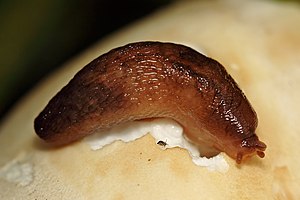Eastern snail
| Eastern snail | ||||||||||||
|---|---|---|---|---|---|---|---|---|---|---|---|---|

Eastern snail ( Lehmannia nyctelia ) |
||||||||||||
| Systematics | ||||||||||||
|
||||||||||||
| Scientific name | ||||||||||||
| Lehmannia nyctelia | ||||||||||||
| ( Bourguignat , 1861) |
The eastern snail ( Lehmannia nyctelia ), also known as loggerhead snail , is a species of nudibranch from the family of snails (Limacidae) that is native to south-eastern Europe . It has now been carried off to temperate regions almost all over the world.
features
When stretched out, the animal measures about 5 cm. The body is slightly gray-yellow in color. On the side there are two dark colored stripes (bandages) that are relatively high up. Two darker bands run near the edges of the cloak shield. Some animals also have an irregular pattern of darker spots on the coat shield, which under certain circumstances can be concentrated in a "central band". There are also almost pale specimens that are almost completely lacking in color patterns and binding. Completely black forms also occur in mountainous regions. The breathing hole is often outlined in dark. The sole is colored light gray, the slime is colorless. The keel is quite short and limited to the back of the foot. In the male part of the genital organs, the cylindrical penis is twisted irregularly or rolled up spirally. The basal part of the penis is usually darkly pigmented. There is no penile gland.
Similar species
The pattern of the eastern snail is very variable and cannot be easily distinguished from Lehmannia marginata with the help of external features .
Geographical occurrence, habitat and way of life
The original range of the species is not known for sure, it is believed to be in the region of Hungary, Romania and Bulgaria. Today the occurrence extends from Bulgaria, Albania, Romania, Hungary over Slovakia, Austria, the Czech Republic to southern Germany and in the north to southern Poland. In the mountains the species rises up to 2,700 m. The species is often found in greenhouses in Europe. In the meantime, the eastern snail has also been transported to North Africa, South Africa, New Zealand, Australia, Japan and the USA.
The species lives in Europe mainly in beech forests, in the mountains also up to above the tree line. She crawls around on trees, rocks and boulders and hides under the bark of trees and under stones.
Hazard and protection
In Bavaria the species is on the red list of endangered snails and mussels (Mollusca), also in Berlin. According to the more recent "Red List of Inner Mollusks (Gastropoda) and Mussels (Bivalvia)) in Germany" from 2009, the species is considered lost or extinct; the last record is from 1967.
Individual evidence
- ^ Zoltán Fehér and Zoltán Péter Eröss: Checklist of the Albanian mollusc fauna. Schr. Malakozool., 25: 22-38, Cismar, Ostholstein, 2009, ISSN 0936-2959
- ↑ Joszef Šteffek, Andrzej Falniowski and Magda Szarowska: Príspevok k topografickému výskumu malakofauny okresu Levice (Contribution to the topographic malacological survey in the Levice District, SW Slovakia). , Malacologica Bohemoslovaca, 4: 21–25, 2005, ISSN 1336-6939 (PDF; 257 kB)
- ↑ Michal Horsak: Lehmannia nyctelia (Bourguignat, 1861) - nový Slimák per Českou republiku ( English Lehmannia nyctelia (Bourguignat, 1861) - the first record in the Czech Republic. ) Uherské Hradiště, Sborník Přírodovědného klubu v Uh. Hradišti, 5, 1-3, 2000 abstract
- ^ GM Barker: Notes on the Introduced Terrestrial Pulmonata (Gastropoda, Mollusca) of New Zealand. Journal of Molluscan Studies, 48: 174-181, 1982 abstract
- ↑ BA Melbourne, PJ Gullan and YN Su: Interpreting data from pitfall-trap surveys: crickets and slugs in exotic and native grasslands of the Australian Capital Territory. Memoirs of the Museum of Victoria, 52 (2): 361-367, 1997, (PDF; 1.1 MB)
- ^ Toshikazu Mito and Tetsuro Uesugi: Invasive Alien Species in Japan: The Status Quo and the New Regulation for Prevention of their Adverse Effects. ( Memento of March 22, 2012 in the Internet Archive ), Global Environmental Research, 8 (2) / 2004: 171-19, 2004 (PDF no longer available)
- ^ Gerhard Falkner, Manfred Colling, Klaus Kittel, Christian Strätz: Red List of Endangered Snails and Mussels (Mollusca) Bavaria. (PDF; 121 kB) Bavarian State Office for the Environment, 2003, accessed on May 23, 2012 .
- ↑ Eva Hackenberg and Volker Herdam: Red List of Endangered Mollusks - Snails & Mussels (Mollusca - Gastropoda & Bivalvia) in Berlin. ( Memento from February 20, 2014 in the Internet Archive ) In: The State Commissioner for Nature Conservation and Landscape Management / Senate Department for Urban Development (ed.): Red lists of endangered plants and animals of Berlin. 2005. (PDF; 230 kB)
- ↑ JH Jungbluth, D. von Knorre (with the collaboration of U. von Bössneck, K. Groh, E. Hackenberg, H. Kobialka, G. Körnig, H. Menzel-Harloff, H.-J. Niederhöfer, S. Petrick, K Schniebs, V. Wiese, W. Wimmer, ML Zettler): Red list of internal mollusks (gastropods and bivalve mollusks in Germany. ), Communications of the German Malacoological Society, 81: 1-28, Frankfurt / M. 2009 (PDF; 1.3 MB) ( Memento from June 16, 2013 in the Internet Archive )
literature
- Michael P. Kerney, RAD Cameron, Jürgen H. Jungbluth: The land snails of Northern and Central Europe. 384 pp., Paul Parey, Hamburg / Berlin 1983, ISBN 3-490-17918-8 .